your inter cooled right?
whats the intake charge temp after boost?
and have you had the heads off?
I wonder how much carbon is caked up in there?
Full Version: 1971 Gold Metallic Project
Small intercooler with fans.
Intake temp says 115, but I'm not confident the IAT is scaled perfectly, so it's only a ballpark figure.
Haven't had the heads off.
Further reducing the dwell didn't do anything, but another 4 degrees off the timing did. But there's still a bit of work to do. I think I need to rescale my timing map to include higher rpm bins and maybe scale the NA portion of it.
We came in to San Francisco today driving my 06 VW Rabbit. Really puts the power of the 914 in perspective, my Rabbit feels S-L-O-W. I remembered I have the iPhone dyno app. Gonna have to try that Sunday and see what it says the car makes.
Intake temp says 115, but I'm not confident the IAT is scaled perfectly, so it's only a ballpark figure.
Haven't had the heads off.
Further reducing the dwell didn't do anything, but another 4 degrees off the timing did. But there's still a bit of work to do. I think I need to rescale my timing map to include higher rpm bins and maybe scale the NA portion of it.
We came in to San Francisco today driving my 06 VW Rabbit. Really puts the power of the 914 in perspective, my Rabbit feels S-L-O-W. I remembered I have the iPhone dyno app. Gonna have to try that Sunday and see what it says the car makes.
Thoroughly enjoying this thread. 
Small intercooler with fans.
Intake temp says 115, but I'm not confident the IAT is scaled perfectly, so it's only a ballpark figure.
Haven't had the heads off.
Further reducing the dwell didn't do anything, but another 4 degrees off the timing did. But there's still a bit of work to do. I think I need to rescale my timing map to include higher rpm bins and maybe scale the NA portion of it.
We came in to San Francisco today driving my 06 VW Rabbit. Really puts the power of the 914 in perspective, my Rabbit feels S-L-O-W. I remembered I have the iPhone dyno app. Gonna have to try that Sunday and see what it says the car makes.
it's really that strong?!
Troy, it's all the torque that really makes the difference.
Pulled more timing. Pinging seems to be under control. My next step on tuning is to optimize the mixture. It's pretty rich under boost (10:1), and I think it's sapping some power. I discovered that the TunerStudio auto-tune has a 'filter' feature. So I can auto-tune to top end, without having it fiddle with the NA section of the VE table (which I'm happy with). Later I may even try to push the timing to the edge and then pull back a couple degrees to make sure I'm getting all I can out of it.
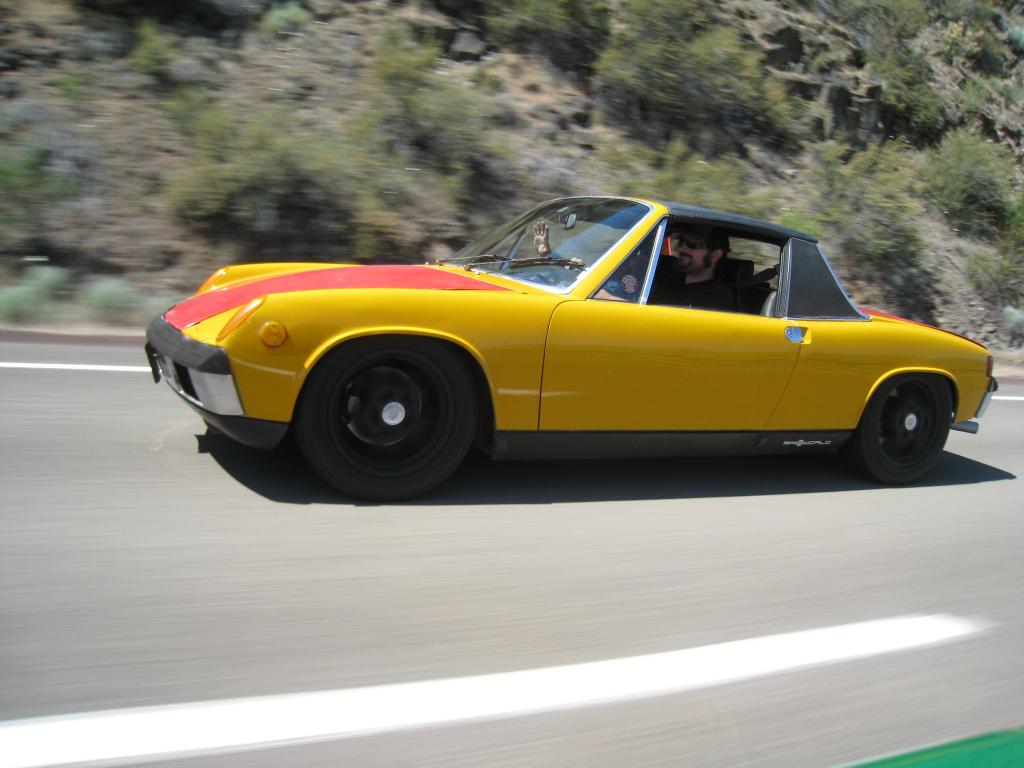
Pulled more timing. Pinging seems to be under control. My next step on tuning is to optimize the mixture. It's pretty rich under boost (10:1), and I think it's sapping some power. I discovered that the TunerStudio auto-tune has a 'filter' feature. So I can auto-tune to top end, without having it fiddle with the NA section of the VE table (which I'm happy with). Later I may even try to push the timing to the edge and then pull back a couple degrees to make sure I'm getting all I can out of it.

McMark , have posted any build specs on the 1.7 turbo engine ??? If so , could you provide a link , search doen't like 1.7 . Thanks ....
Jack
Jack
I have some at work I should post. I keep forgetting that this thread doesn't have any info on the engine.
I believe that there would be many interested , I sure would. Got 2 1.7s in the basement . Improving one of them would be great with a spare engine to boot .Been following this thread since I saw that engine in the Gold Member .
Jack
Jack
Okay, here's some engine info finally.
The base engine is a W-case 1.7, or at least started out life as one. The history of the engine is unknown and could easily have been converted to a 1911. I'll probably never know. Regardless, I haven't done a single thing to the engine itself.
The turbo is a KKK K03 knockoff that I got on eBay for ~$200. It's used by VW and Audi on their 1.6-1.8 engines and I figured it would be a good match for the engine. I knew I wanted something that came onto boost early because I wasn't planning on trying to push to stock engine redline (5500) and I wanted a driver car, not a peak HP race car.
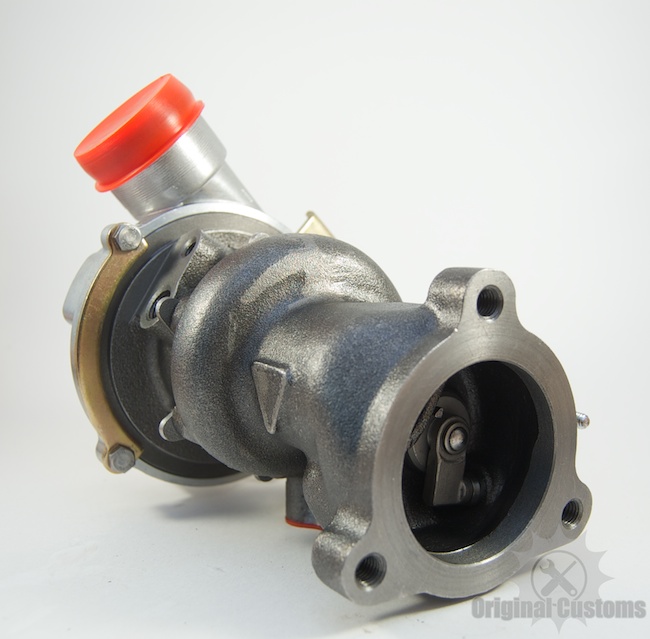
The base engine is a W-case 1.7, or at least started out life as one. The history of the engine is unknown and could easily have been converted to a 1911. I'll probably never know. Regardless, I haven't done a single thing to the engine itself.
The turbo is a KKK K03 knockoff that I got on eBay for ~$200. It's used by VW and Audi on their 1.6-1.8 engines and I figured it would be a good match for the engine. I knew I wanted something that came onto boost early because I wasn't planning on trying to push to stock engine redline (5500) and I wanted a driver car, not a peak HP race car.

I knew I wanted a setup that didn't modify the engine in any way, and I also wanted avoid any body modifications. These two goals were the driving force behind all of my decisions. On the exhaust side, I started with the late 1.8 exhaust because a turbo doesn't care as much about flow (key words, AS MUCH). So this setup simplified the plumbing. It also allowed a reasonable attempt at 'equal length' piping. The passenger side exhaust runs just like a normal 1.8 with a 180-degree turnaround at the front of the engine. The drivers side manifold is flipped to point out the back, and then I fabricated piping to go over the shifter and under the transmission. Both pipes converge behind cylinder #3 and turn 90-degrees upward with my rough approximation of a collector/merge. The mounting flange I made from some thick steel I had laying around.
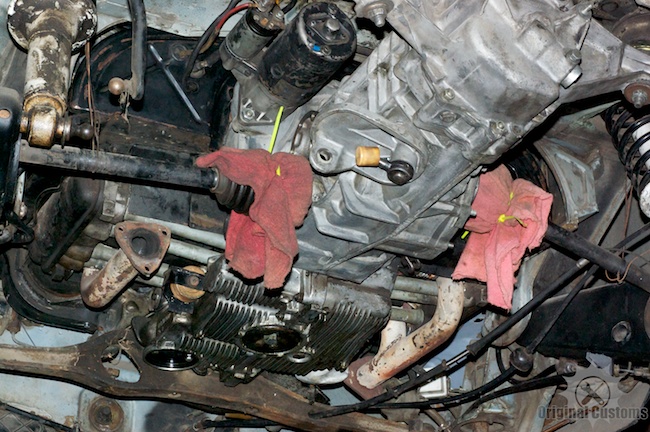
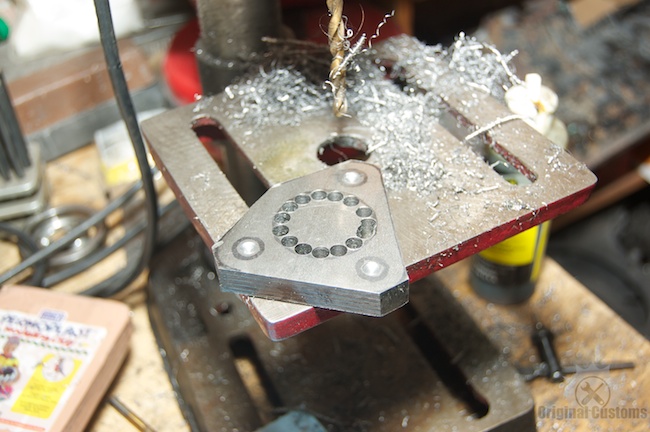
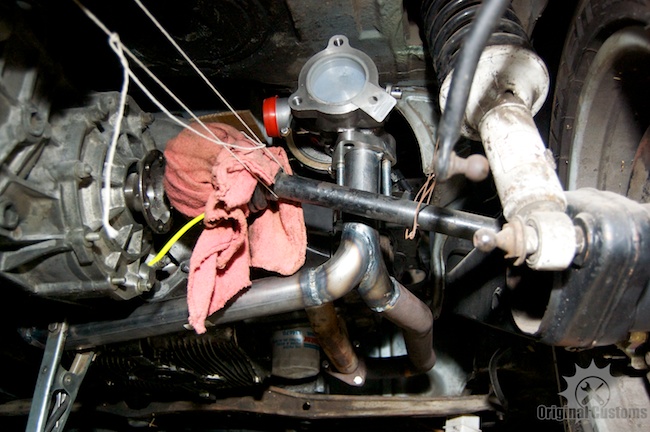
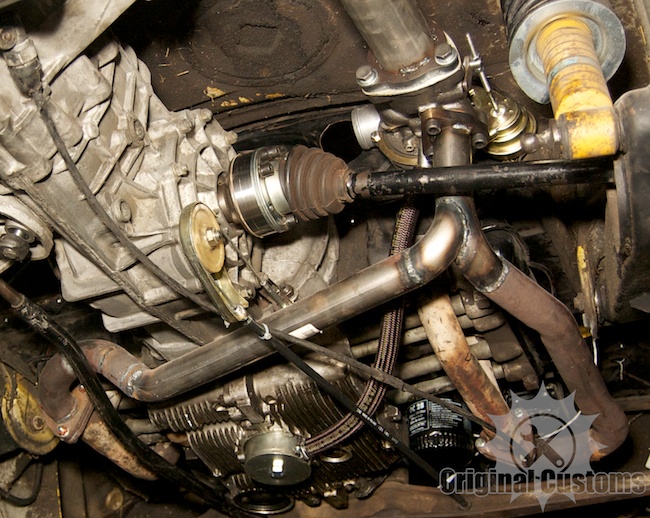




The exhaust exit plumbing was much easier. I ordered up a 2.5" Hooker Header muffler and some piping and it was a straight shot. The piping runs over the axle and I welded a bracket onto the muffler to utilize the stock mounting studs on the transmission.
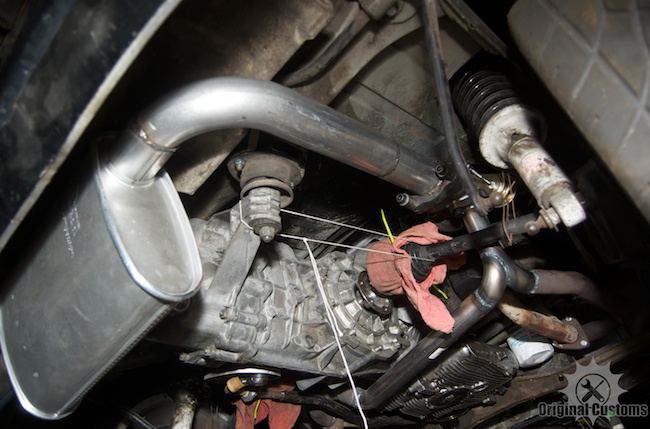

On the intake side, I wasn't planning on running an intercooler, but I was placing an order for another project with Setrab and saw that they had a clearance on all their intercooler cores. So I picked up the smallest one for $125. So I used the stock 1.7 air filter mount pedestal and redesigned it as an intercooler mount. This also acted as a perfect conduit to get air from the PS turbo to the DS throttle body. I first mounted the intercooler to the pedestal, then designed end caps to be laser cut from aluminum (see pic with paper mockups). I love designing crazy shapes that I can bend, rather than a bunch of plates that I weld together. I was even able to design the cutouts for the round inlet/outlet pipes. The intercooler end caps are each made from a single piece of aluminum. I also designed a fan mount/plenum. I have two SPAL 4" puller fans on the back. This was one of my first aluminum welding projects. 
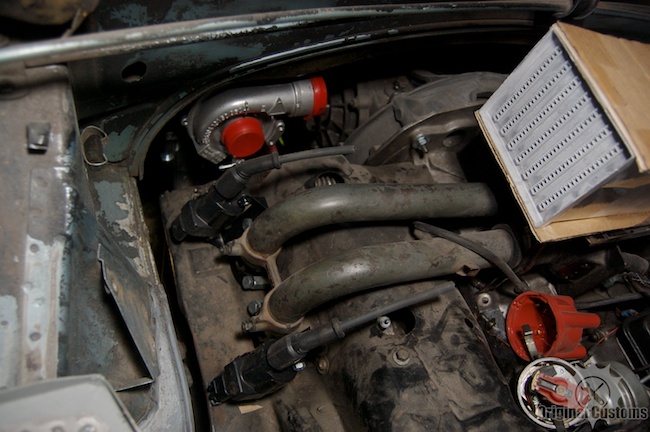
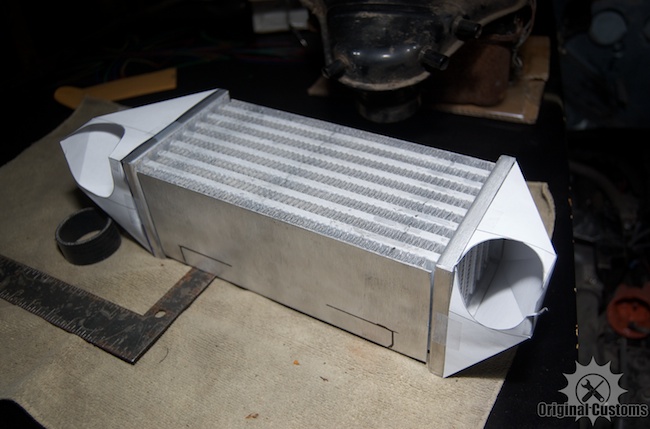
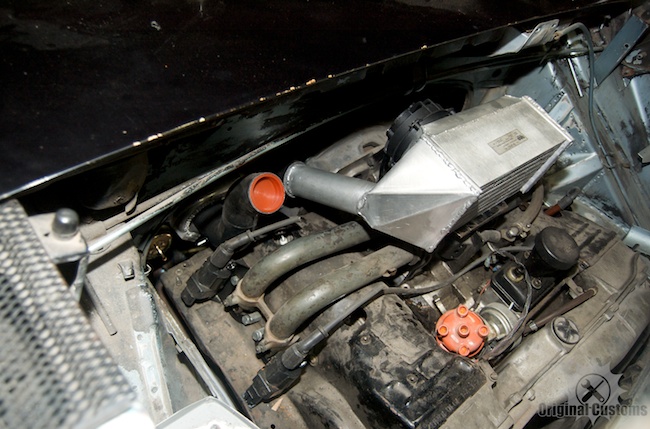
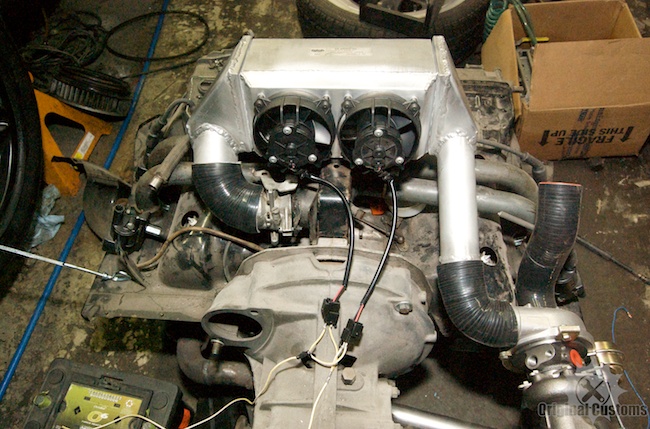




The air cleaner is a stock 2.0 unit that I modified by taking off the 'snorkel' and welding mesh in its place. I also cut off the section that normally attaches to the 2.0 throttle body, and welded some pipe at a 45 degree angle to feed right at the turbo intake.
Turbo oiling is supplied from the oil pressure switch location. I used AN-3 plumbing and added a tee inline for two reasons. First is that it mounts my oil pressure sender unit, and secondly I brazed and drilled the outlet (to turbo) to restrict the pressure. Before this I was blowing oil past the bearings. Oil return is via a steel flange and pipe that I used AN-10 line with, and I drilled and welded a pipe into a tuna-can for the other end of the hose. There was some concern expressed that oil return should be above the oil pan. But since the original Audi/VW 1.6-1.8 engines do it this way, I figured I'd take the risk. I haven't seen a problem with this setup.
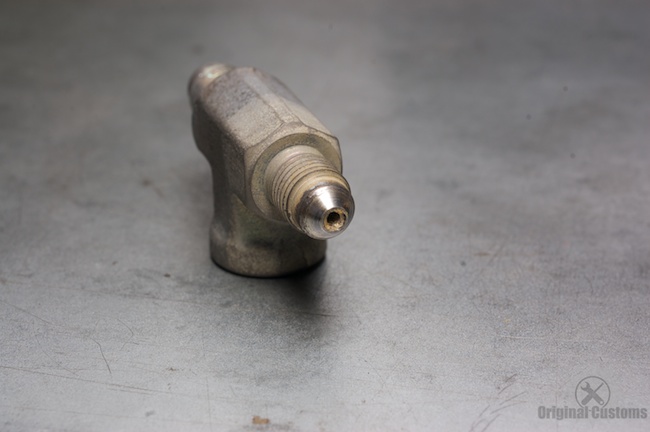
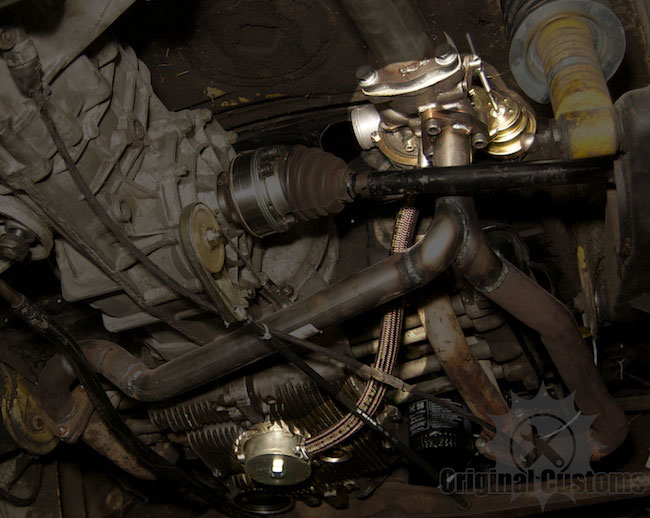
Turbo oiling is supplied from the oil pressure switch location. I used AN-3 plumbing and added a tee inline for two reasons. First is that it mounts my oil pressure sender unit, and secondly I brazed and drilled the outlet (to turbo) to restrict the pressure. Before this I was blowing oil past the bearings. Oil return is via a steel flange and pipe that I used AN-10 line with, and I drilled and welded a pipe into a tuna-can for the other end of the hose. There was some concern expressed that oil return should be above the oil pan. But since the original Audi/VW 1.6-1.8 engines do it this way, I figured I'd take the risk. I haven't seen a problem with this setup.


Nice setup
Nice setup. I like your oil return. Do you see any problems with returning to the valve cover from the position the turbo is in now? I am thinking that is where im going to mount mine and that was my original plan but draining back to the sump looks better.
Sorry for the hijack but here is the turbo I will be using, I had it on my old T1 sandrail so hopefully it should be good for the teener.
Its actually a really small T3 off of an old volvo.
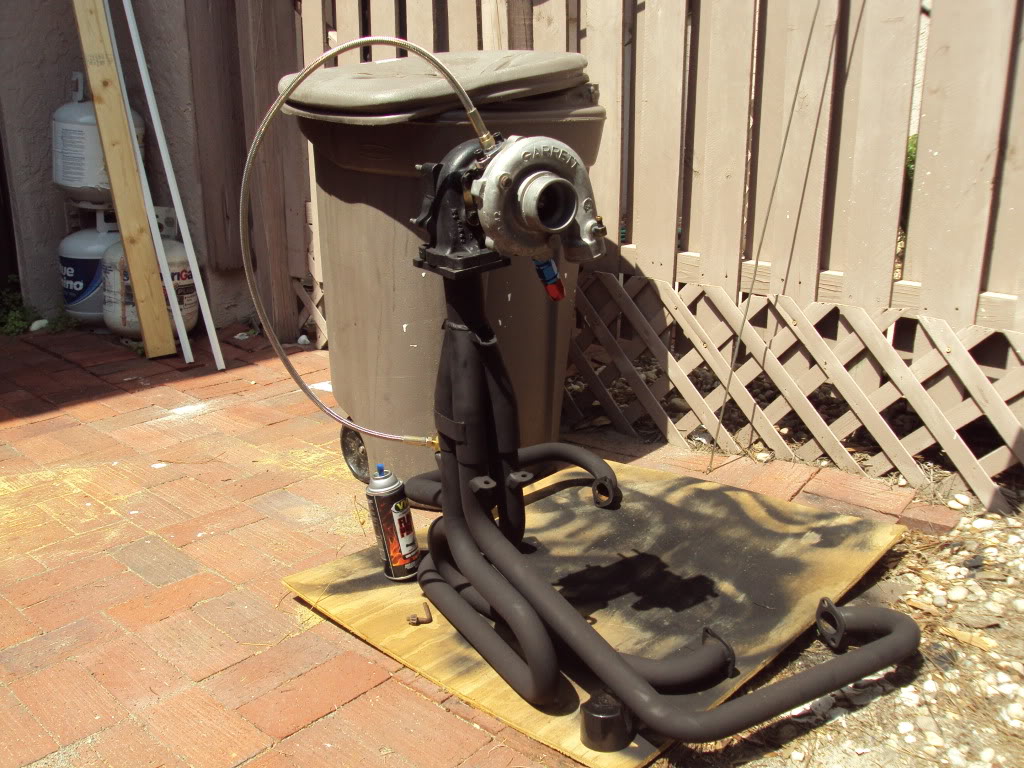
 Thanks for the inspiration!
Thanks for the inspiration!
Kevin
Sorry for the hijack but here is the turbo I will be using, I had it on my old T1 sandrail so hopefully it should be good for the teener.
Its actually a really small T3 off of an old volvo.

Kevin
any plans to dyno this setup to see what you can reliably make for bolt on power?
rich
rich
QUOTE
Do you see any problems with returning to the valve cover from the position the turbo is in now?
I didn't want to drain back to the valve cover because it would make valve adjustments a PITA. Plus under hard cornering the sump empties most of its oil into the valve cover, so that may be a problem. Don't get me wrong. It probably would work just fine, but too many compromises for me.QUOTE
Its actually a really small T3 off of an old volvo.
T3s are really common. What size engine are you putting it on? For a 2.0+ it's probably great, but for a 1.7 I expect it would make boost too late (IMHO).QUOTE
any plans to dyno this setup to see what you can reliably make for bolt on power?
Yeah. Supposedly there is a dyno shop in Napa. Just need a few hours free to go search it out. I think it's tuned well enough to see.
You're probably right on it being a little too big for my 1.7. Its a .42/.48. Im not sure of the trim.
I've had this lying around for years but at the price you got that turbo for it would be tough not to just avoid the trouble and buy one a little better suited to the engine.
And you definitely make a good point about the valve covers, I never even thought about valve adjustments...
Thanks again and keep us posted (would love to see some video!! )
)
Kevin
I've had this lying around for years but at the price you got that turbo for it would be tough not to just avoid the trouble and buy one a little better suited to the engine.
And you definitely make a good point about the valve covers, I never even thought about valve adjustments...
Thanks again and keep us posted (would love to see some video!!
Kevin
People have asked for video, but I really can't imagine what to video. It sounds just like a normal 914 and nothing moves in such a way that would show up on video.
What would you like to see?
What would you like to see?
Any video with a 914 in it is worth watching! 
I was just thinking a walkaround to show the setup and maybe an in car through the gears. It would be cool to see the difference in how quickly it gets up to speed in relation to a stocker.
After seeing this thread I wish I would have done the turbo before/instead of the ITBs, but its all good fun.

I was just thinking a walkaround to show the setup and maybe an in car through the gears. It would be cool to see the difference in how quickly it gets up to speed in relation to a stocker.
After seeing this thread I wish I would have done the turbo before/instead of the ITBs, but its all good fun.
I'd like to see how quickly it builds boost while driving.
QUOTE
any plans to dyno this setup to see what you can reliably make for bolt on power?
Yeah. Supposedly there is a dyno shop in Napa. Just need a few hours free to go search it out. I think it's tuned well enough to see.Wally on STF got near 400HP with a 2.0 liter motor...
Then he built a bigger motor.
Go look for that thread when you have time...its a great learning experience.
I bet you can get into the 150hp range with the 1.7 if you are tuned right.
It sure would be cool to see, and I suspect if you get it all canned, and simple, you will get at least a few clients for it.
The old 1.7 is the tank motor...little head sealing issues.
Rich
I'll have to read that thread again. I know I read it before. I think my biggest issue is the static compression ratio of my engine. SOMETHING is holding me back, but I can't figure out what... yet. I might try an octane booster (as suggested to me in a PM).
I also need to go over the basics now that I have 1000 miles on it. Adjust the valves, change the oil, check bolts, etc.
I also need to go over the basics now that I have 1000 miles on it. Adjust the valves, change the oil, check bolts, etc.
You really need to consider a methanol system. It will raise your effective octane level, Stop your pinging, cool your intake air temp and make you more HP!!! Oh, and it will prevent you from melting a piston!
I run a progressive system that increases fluid pressure with boost. 20psi=10%, 30psi=100%. You would only need a small single injector that could be mounted anywhere.
On my system (2 gallon), I run a single 330cc injector before the throttle body. This size is good for 350hp @ 7000rpm. You would need half that size and a much smaller tank. The injector mounts to a 1/8NPT bung and they have "add a bung" that can be mounted to silicone couplers. I also have a level switch that alerts the gauge when I run low.
You can also make your own mix with denatured alcohol and water. Or, you can buy pre mixed juice. Chemically they are almost identical. I can get 4 gallons of "Boost Juice" on ebay for ~$50 or a gallon of Denatured at home depot for $15. It is a simple 50/50 mix. I am also running a Root Beer aroma in the meth. I can smell it every time it kicks in.
Now I realize you are trying to tune the detonation out, but if the static compression is the problem, you may not be able to. The methanol will cure this and have added benefits. Super simple install too.
http://www.coolingmist.com/
http://www.alcohol-injection.com/en/
http://www.alcoholinjectionsystems.com/Wat.../c28/index.html
I run a progressive system that increases fluid pressure with boost. 20psi=10%, 30psi=100%. You would only need a small single injector that could be mounted anywhere.
On my system (2 gallon), I run a single 330cc injector before the throttle body. This size is good for 350hp @ 7000rpm. You would need half that size and a much smaller tank. The injector mounts to a 1/8NPT bung and they have "add a bung" that can be mounted to silicone couplers. I also have a level switch that alerts the gauge when I run low.
You can also make your own mix with denatured alcohol and water. Or, you can buy pre mixed juice. Chemically they are almost identical. I can get 4 gallons of "Boost Juice" on ebay for ~$50 or a gallon of Denatured at home depot for $15. It is a simple 50/50 mix. I am also running a Root Beer aroma in the meth. I can smell it every time it kicks in.
Now I realize you are trying to tune the detonation out, but if the static compression is the problem, you may not be able to. The methanol will cure this and have added benefits. Super simple install too.
http://www.coolingmist.com/
http://www.alcohol-injection.com/en/
http://www.alcoholinjectionsystems.com/Wat.../c28/index.html
I vote for the root beer injection. 
Use real beer, some home brew.
A beer cooled turbo 914 would be classic
A beer cooled turbo 914 would be classic
Your advice certainly isn't falling on deaf ears Mike. I guess I just want to do some more trial and error learning before I step into a new system. I will look at the MicroSquirt's ability to control the Meth Injection.
Just had a brain wave. I installed a new CHT last week and found that the stock unit maxes out (mine reads 215 degrees max). I bet the stock intake sensor is the same way. I haven't seen over 122 degrees on the intake air temp sensor. I think tomorrow I'll gut a stock IAT and stuff a new thermistor inside and try and get some real intake temps.
Looked up the compressor map for the K03 and overlaid flow calculations at my current 5psi (yellow) and at 12psi (blue). At my current boost, I'm missing the most efficient part of the map.
I wonder if I could be inducing extra heat in the intake charge because I'm not in the best area. Could this setup run better on more boost?
I wonder if I could be inducing extra heat in the intake charge because I'm not in the best area. Could this setup run better on more boost?
You need to know your actual air temp. I'm sure you're leaving hp on the table. GM sensors are cheap and pretty accurate.
You also may have too much heat soak in the intercooler to be effective. Do you have pics of the mounting?
Air to water intercoolers are 7X more efficient. Maybe you could incorporate one into your system. I have an extra pump I'll give you if you go that route.
You also may have too much heat soak in the intercooler to be effective. Do you have pics of the mounting?
Air to water intercoolers are 7X more efficient. Maybe you could incorporate one into your system. I have an extra pump I'll give you if you go that route.
How are you tuning effectively if you don't know engine size
I've only ever done ve on a haltech which needs engine size to calculate injector time
Just curious
Edwin
I've only ever done ve on a haltech which needs engine size to calculate injector time
Just curious
Edwin
QUOTE
How are you tuning effectively if you don't know engine size
Tuning by mixture and butt-dyno. What does engine size have to do with it? I can see how it would be immensely helpful, but certainly not necessary.QUOTE
GM sensors are cheap and pretty accurate.
Waiting for the epoxy to dry on my 'new' stock IAT sensor. This thermistor goes up to 257F. I could get a GM sensor, but this one is Original yet Custom.
If you are just using injection time then engine size doesn't matter but if using ve tables I thought the computer compares to engine size and injector size
As I say I've not used a mega squirt so just trying to learn
As I say I've not used a mega squirt so just trying to learn
You're right, but only as far as getting the engine started. MegaSquirt will develop a BASIC VE table for you based on engine size and injector size. But once that calculation is done and you start actually tuning the engine based on WBO2 readings engine size and injector size become irrelevant. You just watch your WBO2 readings and add fuel where it's lean and remove fuel where it's rich.
Well, the new IAT had pretty much the same numbers. I little higher, but who knows how close this calibration is and how close the other's calibration was. Peak IAT was 138 degrees according to this sensor.
I don't think temperature is my problem.
I don't think temperature is my problem.
Use a dynamic compression ratio calculator.
"Your dynamic boost compression ratio, reflecting static c.r., cam timing, altitude, and boost of 5 PSI is 10.52 :1."
I ran the same with 12PSI and it came to 14.25:1.
With the WebCam 119 cam it's 9.85 @ 5psi and 13.35 @ 12psi.
I think it's time to listen to Mike and try some water injection. Otherwise, I may have found the limit of a stock turbo'd setup. Which really isn't too shabby. But since this is a learning project, gotta keep going.
Also, a cam swap would allow more boost.
"Your dynamic boost compression ratio, reflecting static c.r., cam timing, altitude, and boost of 5 PSI is 10.52 :1."
I ran the same with 12PSI and it came to 14.25:1.
With the WebCam 119 cam it's 9.85 @ 5psi and 13.35 @ 12psi.
I think it's time to listen to Mike and try some water injection. Otherwise, I may have found the limit of a stock turbo'd setup. Which really isn't too shabby. But since this is a learning project, gotta keep going.
Also, a cam swap would allow more boost.
138° is too high for me. I like mine 120° or lower. You also have additional heat in the intake runners due to conduction from the head. And the runners are steel and don't dissipate heat well.
I don't have any real numbers on intake temp reduction with methanol BUT... When the injector kicks on, my exhaust temps, (EGT 8" after turbo) drop 200° instantly and continue to drop as long as the system is running. I have witnessed the temp going from 1400° to 800° in a matter of seconds. All due to the combustion temps dropping.
Do you have phenolic spacers on the intake runners? This also helped drop intake temps on mine.
You might also try an even colder plug. Keep stepping down temp until the plugs foul, then go back to the next hotter one.
I don't have any real numbers on intake temp reduction with methanol BUT... When the injector kicks on, my exhaust temps, (EGT 8" after turbo) drop 200° instantly and continue to drop as long as the system is running. I have witnessed the temp going from 1400° to 800° in a matter of seconds. All due to the combustion temps dropping.
Do you have phenolic spacers on the intake runners? This also helped drop intake temps on mine.
You might also try an even colder plug. Keep stepping down temp until the plugs foul, then go back to the next hotter one.
Yeah, I have the phenolic spacers.
Pump, nozzle, hose ordered.
Pump, nozzle, hose ordered.
Hate to say it...but...based on the evidence presented...
You CAN turbo a 914...
You CAN turbo a 914...
You say you reached the limit, but what is the limit?
Good point. What are you trying to achieve Mark. What is the intended purpose for this application? You can continue to chase HP, but at what expense. The F1 1.5L engines in the late 80's where hitting 800bhp on rocket fuel, but had no longevity.
"Originally the turbo F1 engines from Renault, Ferrari, and BMW were running gasoline, but the rulemakers allowed "rocket fuel" which was actually gelled toluene.You know for damn sure it burnt super slow if it was gelled so it must have had some crazy high octane equivalent. With the new rocket fuel, the other engine manufacturers were already surpassing 800bhp in 1985. This 1.5L BD based 4 cylinder engine with staged turbos was bending crankshafts at 3.0 bar (absolute) boost @ 11,000rpm. Even with a redesigned crank and flywheel the complexity of the turbo setup and transmission was probably a complete clusterfcuk. I'm sure the engine only having 4 cylinders was probably another limitation for increasing power beyond 650bhp reliably. You have to remember that this was 1987 before the time of 3D modeling, FEA, simulations, etc. While Duckworth did redesign the clutch and flywheel to live at that power output, it was clear that it was going to be an uphill battle with a 4 banger. The good old boys in NASCAR back then probably weren't making 650bhp out of their 5.7L small blocks yet and here was the F1 crowd playing with 1.5L engines."
------------------------------------------------
Turbo ecotech's running close to 300hp-
" LNF
Ecotec LNF in a Pontiac Solstice
A turbocharged direct injected (redubbed Spark Ignition Direct Injection) Ecotec was introduced in the 2007 Pontiac Solstice GXP and Saturn Sky Red Line. In these applications, the engine is mounted longitudinally. Displacement is 2.0 L—1,998 cc (121.9 cu in)—with a square 86 millimetres (3.4 in) bore and stroke. Compression is 9.2:1 and maximum boost is 1.4 bar (20.0 psi), delivering 260 hp (190 kW) at 5300 rpm and 260 lb·ft (350 N·m) of torque from 2500 to 5250 rpm. Engine redline is at 6300 rpm and premium fuel is recommended. The sodium filled exhaust valves were based on technology developed for the Corvette V8 powertrains. The sodium fuses and becomes a liquid at idle, which improves conductivity and draws heat away from the valve face and valve guide towards the stem to be cooled by the engine oil circulating in this area. The camshaft-driven direct injection systems pressurizes the fuel to 31 bar (450 psi) at idle, and up to 155 bar (2,250 psi) at wide-open throttle. The "Gen II" block is similar to the 2.4 L and also features VVT technology. The Gen II block was developed using data from racing programs and computer simulations. The bore walls and bulkheads were strengthened with a weight increase of 1 kg (2.5 pounds). The coolant jackets were expanded to improve heat transfer, resulting in a coolant capacity increase of 0.5 liters.
In December 2008, GM released a Turbo Upgrade Kit for the LNF engine which increases horsepower to 290 hp (220 kW) and torque to up to 340 lb·ft (460 N·m), depending on the model. The kit retails for $650 and includes remapped engine calibration and upgraded MAP sensors. The kit is covered by the cars' existing GM warranties.[3]
Unique LNF features[4] include:
a twin-scroll turbocharger
cam-driven high-pressure gasoline direct injection fuel system
dual camshaft continuously variable valve timing
sodium-filled stainless steel Inconel exhaust valves
low-friction cast aluminum pistons with oil squirters
forged steel crankshaft
forged steel connecting rods
cast stainless steel exhaust manifold"
------------------------------------------------
Slippery slope $$$.
But to the point, are you building a daily driver, putting a kit together, do you want to stop and add water, alcohol, octane boosters? Or if this is a one off then go for it, bigger injectors, bigger turbo, racing fuel? Reliability? HP?
Seems to me, by the interest from the community a kit would be well received. Then, a bolt on with zero driver involvement? Or a weekend only package with adding water/alcohol/root beer? Tailored to each buyer? Bolt on with stock internals? Forged?
Actually, I'm going after education. This project was never about building an engine for my car. In fact, I had a 2270 ready to bolt in and drive, but I chose the turbo 1.7 because it can teach me more. I want to try out the water injection because I'm curious just how large of an effect it can have.
In that case I really think you need to get it on a dyno ASAP. Measure and quantify each step. I'd be interested in seeing each step and the power curve too.
Mark are you sure you want me to sell the 1.7 in my garage......seems if you keep pushing that one you may need it? 

Jeff
Jeff
But I've got a stack of spares out in the side yard... 

are you using a multi spark system?
something to decrease the chance of detonation?
Does the megasquirt platform support tuning of a multi spark system?
Rich
something to decrease the chance of detonation?
Does the megasquirt platform support tuning of a multi spark system?
Rich
This is a "lo-fi" version of our main content. To view the full version with more information, formatting and images, please click here.
